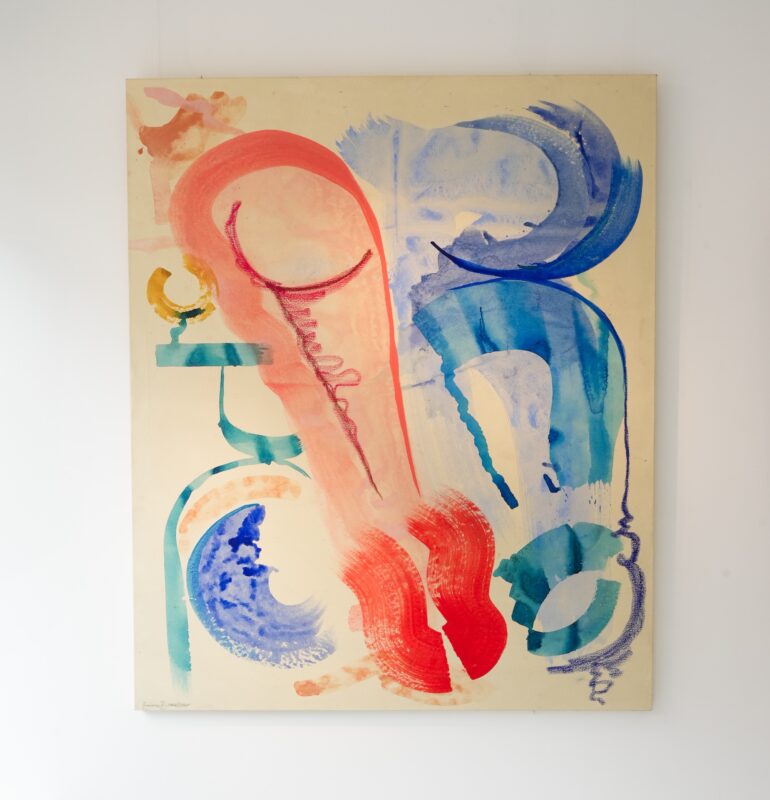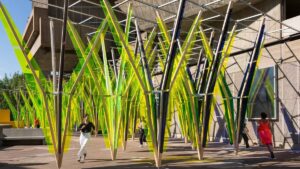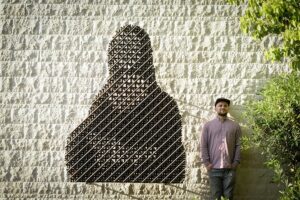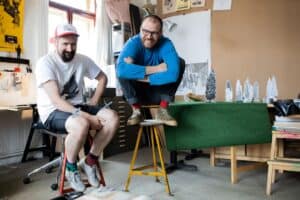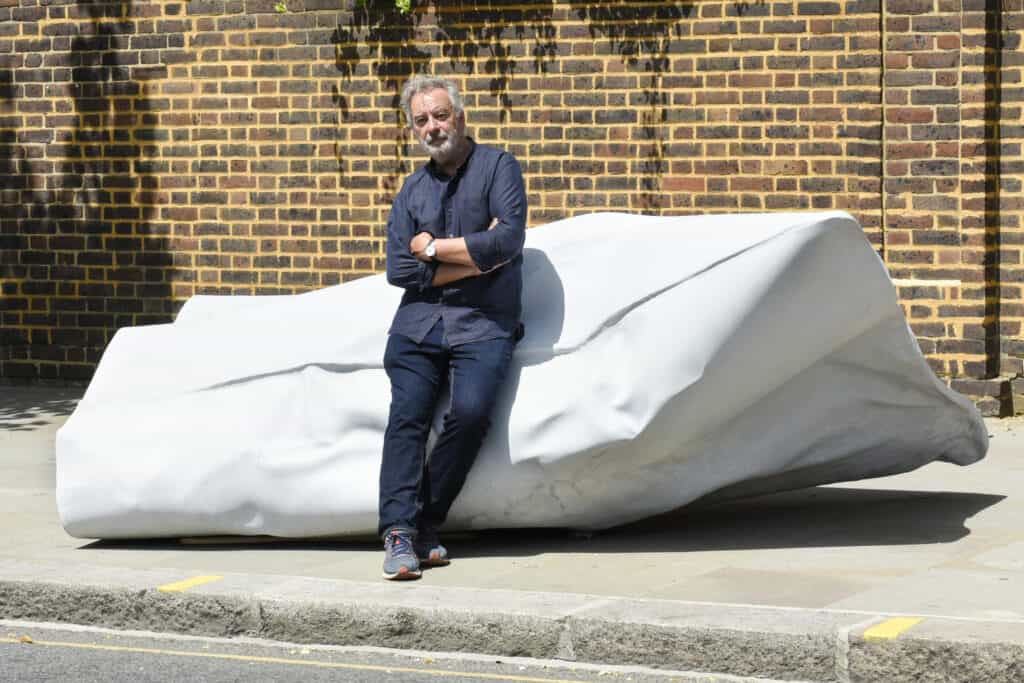
A large sedentary concrete form has appeared as if out of nowhere on High Street Kensington. Richard Mackness ‘Domus’ is monumental, mirroring the passing cars in its scale. Placed conspicuously on the pavement, it leaves the viewer asking a number of questions – namely, what is it, and where did it come from?
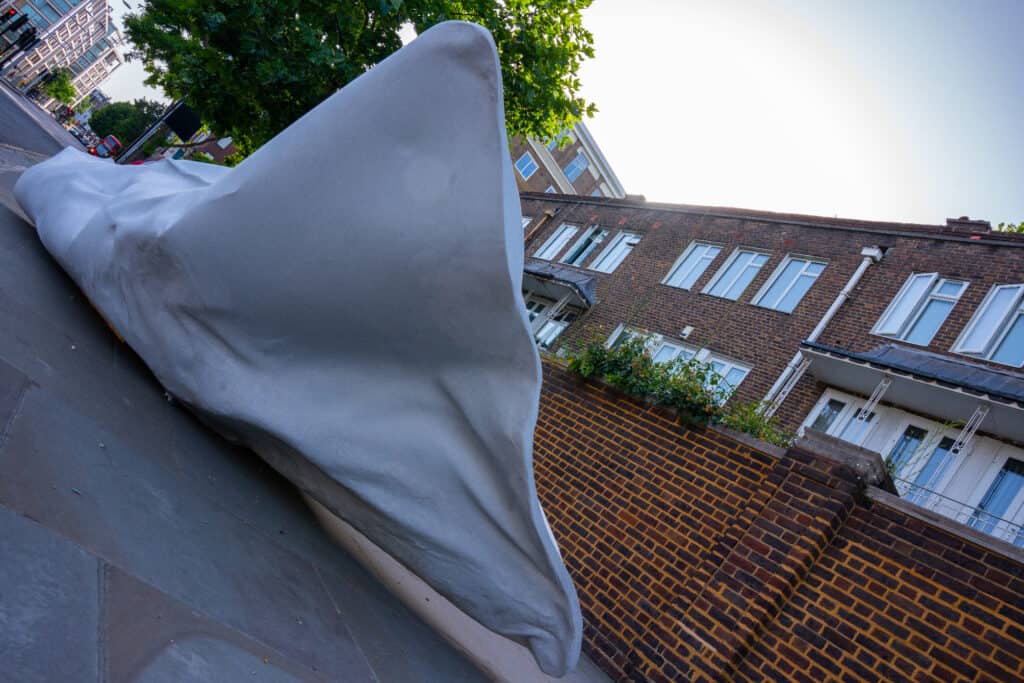
The object resists classification; it resembles a shelter, a cave, possibly a bag. The sculpture’s form is, in fact, drawn from a disregarded crisp packet which the artist collected and worked with for a series of pieces. The aggrandisation of a lowly scrap of rubbish as a large-scale sculpture serves to force our attention to that which we often overlook. When we come across a piece of litter on the street, we barely register its presence, yet Mackness’ ‘Domus’ invites us to actively encounter.
Both the artwork’s name and form recall classicism – there is something of the drapery seen in Renaissance nudes at play within the curves and undulations of the surface. Further, the use of one unpainted material for the entire piece brings to mind Michelangelo’s Marbles, set free from stone with a chisel rather than pieced together from multiple materials. The sculpture is therefore at an odd tension, between the piece of trash from which it was conceived, and the histories of high-art with which it visually engages.
The material choice is also key to understanding the work, cast in concrete – a substance affiliated with the quick, cheap build and architectural movements such as brutalism. What the eye is unable to see, however, is that the sculpture is surprisingly light as it is made delicately from glass reinforced concrete.
In this sense, ‘Domus’ is a piece exploring deception and the spaces between binaries. It is neither waste object nor precious object, neither as heavy as it appears, nor as light as the crisp packet from which it was derived. It may seem like a container or vessel, yet there is nothing held inside.
The artist behind ‘Domus’, Richard Mackness is well recognised as a leader in large-scale contemporary sculpture. He has exhibited across the UK, in New York and Europe including at Manchester Contemporary, Camden Arts Centre, Whitechapel Gallery, Ikon Gallery, and Yorkshire Sculpture Park. I caught up with him to learn more about the ever intriguing, ‘Domus’ and his participation in KCAW 2022.
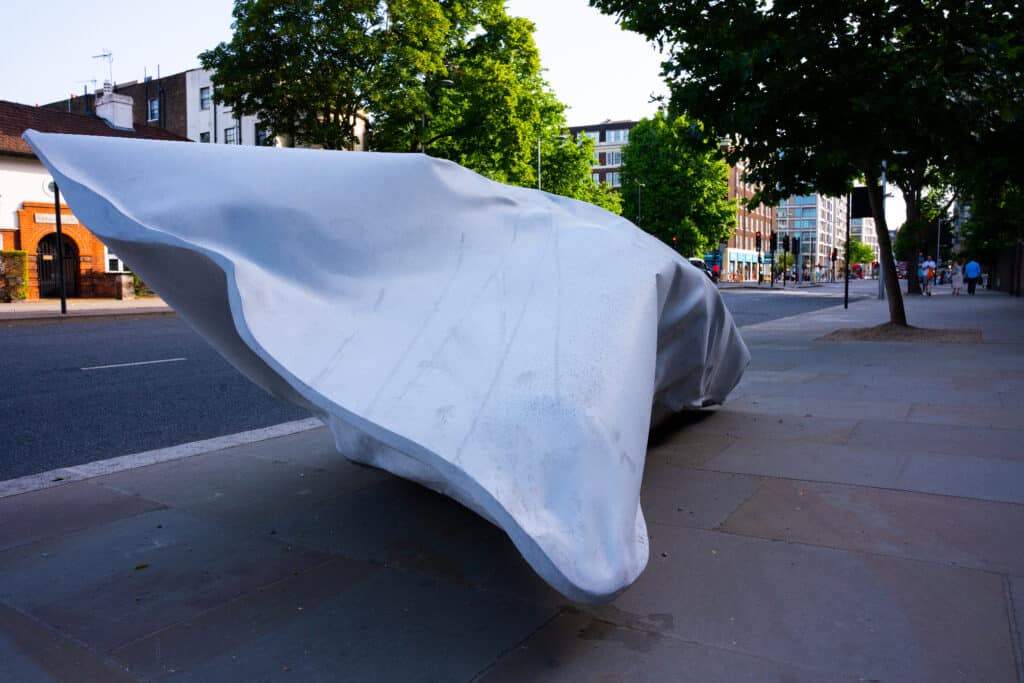
What excites you about this year’s Kensington + Chelsea Art Week Public Art Trail?
It’s good to be part of an event which puts art on the street – a non-commercial contribution amongst all the ads. Also, I have spent many hours enthralled by the objects in the museums in this area – there really is so much to see and to learn. You could say it’s pay-back time!
Describe the work ‘Domus’ currently exhibited on Kensington High Street- how did it come about? What do you hope people take from the work?
‘Domus’ developed out of a new series of works which began few years ago when I was asked to make a piece using a found object – I chose a Walkers Crisp Packet I had found blowing around the street. It interested me as something at once present and ubiquitous yet also very invisible.
As any archaeologist will tell you, there is much to be learned from the things a culture throws away. With the found object project, several of strands of thought in my work came into focus, especially the dichotomy between something as worthless or priceless.
I decided to electroplate the soft crinkly plastic packet with copper, forming a shell of metal around it; suddenly it was transformed into a kind of relic, it shifted from contemporary every day object to something that felt ancient, classical and monumental.
When it came to scaling up this idea, it was important to me that ‘Domus’ remained a single object made from a single material, in keeping with the classical definition of sculpture. The making of this piece was complex, involving the creation of giant, bag like form out of stiff plastic sheet that was heat-formed to soften and manipulate. This was then re-enforced with steel and a fine concrete shell cast inside.
Materials and the references they carry are a really important part of my practice – there is a kind of alchemy at work when choosing to transform a thing from one material to another which can have tremendous power.
How do you plan for your work to engage with public space? What interpretations do you think unsuspecting passers-by might have?
Sculpture is primal – it triggers an unconditioned response which goes straight to the main switch-board inside us. So, when a person encounters this piece although the response is individual, the primary drivers are emotional, – we respond to a smooth undulating form as if it shares something human. There is a resonance with these packaging forms that ‘sleep’ on our streets, deformed, torn apart and emptied.
Your work engages with dualities and the spaces between binaries – for example: Synthetic / Evolved, Earthly / Divine, Priceless / Worthless, how are these ideas imbued in the work?
For me, as an analogue native, I see the digital age as acting as a powerful solvent on the established structure and order of things. Boundaries are dissolving between the political and the corporate, the private and the public, between science and religion. There is a sense of things being in a state of flux, of uncertainty, one might say paranoia. I look to capture some of this in these pieces, observed from worthless fragments found on the street.
What’s next for you in 2022?
For 2022 lots to do – I have just moved studio into great building with high ceilings and an outdoor area that runs down to the banks of the river Foss. I have been longing to get a huge mountain of clay to dive into, like when I was a child, making Roman soldiers and monsters with clay from banks of the river Ouse near our house. In a sense, it’s back to the future! Plus, I’m in a group show in Chemnitz in Germany at the end of the year.
Richard Mackness’ ‘Domus’ is on Display on Kensington High Street as part of Kensington + Chelsea Art Week Public Art Trail 2022.
Returning this year for its fifth annual edition, Kensington + Chelsea Art Week Public Art Trail 2022features exciting sculpture and installation pieces spanning the borough. This year, works are on display by Sokari Douglas Camp CBE, Azzar Amoy, Maya Sanbar, Gavin Turk, Konstantin Benkovich, Charlotte Colbert, Kipling Hunt, Roman Lokati, David Böhm & Ji?í Franta, Lise Bouissiere, Birungi Kawooya & Bokani Tshidzu and Richard Mackness.
To View a Map of the Art Trail Locations and Plan Your Visit Click Here
Find out more about Kensington + Chelsea Art Week: kcaw.co.uk | @kcawlondon
Find out more about Richard Mackness: richardmackness.com/sculpture | @richardmackness
